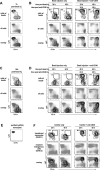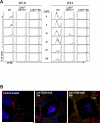Inflammatory spleen monocytes can upregulate CD11c expression without converting into dendritic cells
- PMID: 22442444
- PMCID: PMC4594880
- DOI: 10.4049/jimmunol.1102741
Inflammatory spleen monocytes can upregulate CD11c expression without converting into dendritic cells
Abstract
Monocytes can differentiate into various cell types with unique specializations depending on their environment. Under certain inflammatory conditions, monocytes upregulate expression of the dendritic cell marker CD11c together with MHC and costimulatory molecules. These phenotypic changes indicate monocyte differentiation into a specialized subset of dendritic cells (DCs), often referred to as monocyte-derived DCs or inflammatory DCs (iDCs), considered important mediators of immune responses under inflammatory conditions triggered by infection or vaccination. To characterize the relative contribution of cDCs and iDCs under conditions that induce strong immunity to coadministered Ags, we analyzed the behavior of spleen monocytes in response to anti-CD40 treatment. We found that under sterile inflammation in mice triggered by CD40 ligation, spleen monocytes can rapidly and uniformly exhibit signs of activation, including a surface phenotype typically associated with their conversion into DCs. These inflammatory monocytes remain closely related to their monocytic lineage, preserving expression of CD115, scavenging function, tissue distribution and poor capacity for Ag presentation characteristic of their monocyte precursors. In addition, 3-4 d after delivery of the inflammatory stimuli, these cells reverted to a monocyte-associated phenotype typical of the steady state. These findings indicate that, in response to anti-CD40 treatment, spleen monocytes are activated and express certain DC surface markers without acquiring functional characteristics associated with DCs.
Figures






References
-
- French RR, Chan HT, Tutt AL, Glennie MJ. CD40 antibody evokes a cytotoxic T-cell response that eradicates lymphoma and bypasses T-cell help. Nat Med. 1999;5:548–553. - PubMed
-
- Lefrancois L, Altman JD, Williams K, Olson S. Soluble antigen and CD40 triggering are sufficient to induce primary and memory cytotoxic T cells. J Immunol. 2000;164:725–732. - PubMed
-
- Clarke SR. The critical role of CD40/CD40L in the CD4-dependent generation of CD8+ T cell immunity. Journal of leukocyte biology. 2000;67:607–614. - PubMed
-
- Bonifaz L, Bonnyay D, Mahnke K, Rivera M, Nussenzweig MC, Steinman RM. Efficient targeting of protein antigen to the dendritic cell receptor DEC-205 in the steady state leads to antigen presentation on major histocompatibility complex class I products and peripheral CD8+ T cell tolerance. J Exp Med. 2002;196:1627–1638. - PMC - PubMed
Publication types
MeSH terms
Substances
Grants and funding
LinkOut - more resources
Full Text Sources
Research Materials

